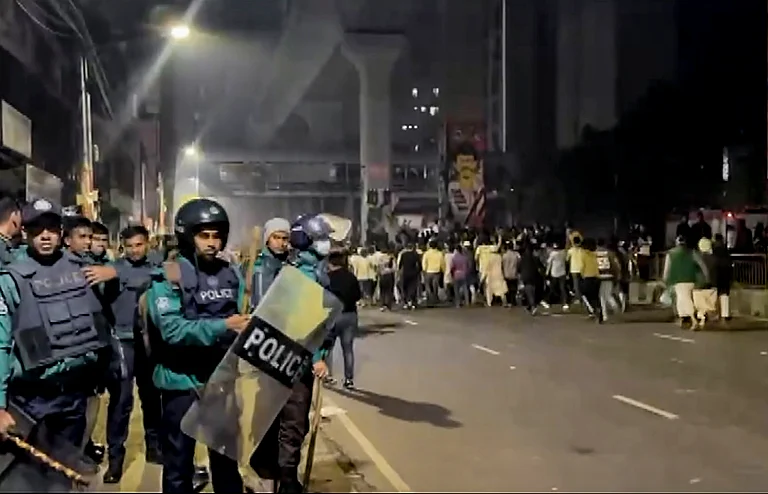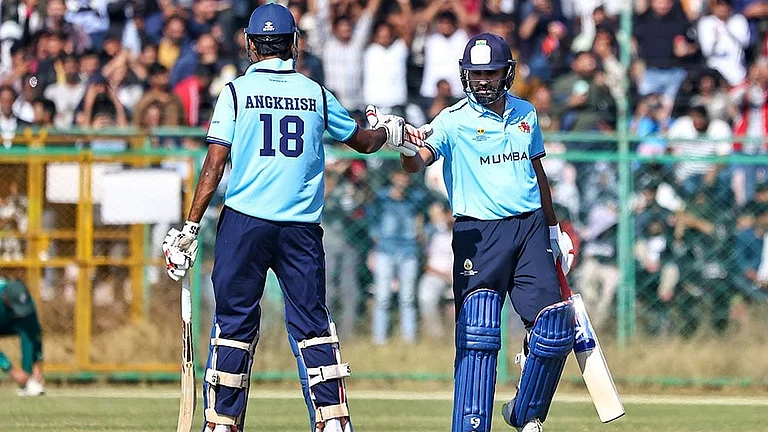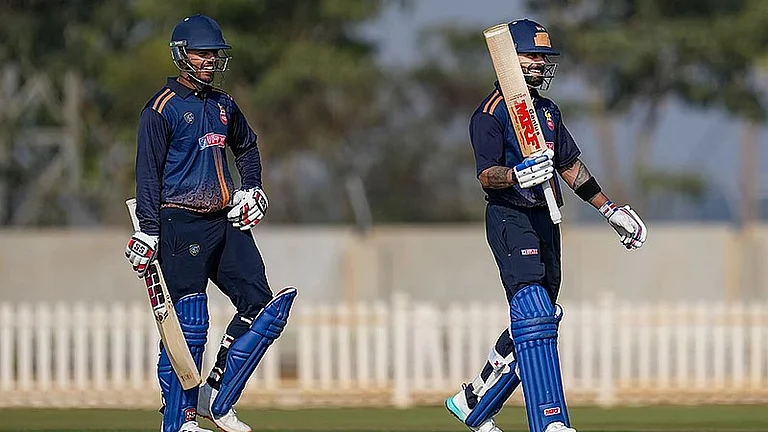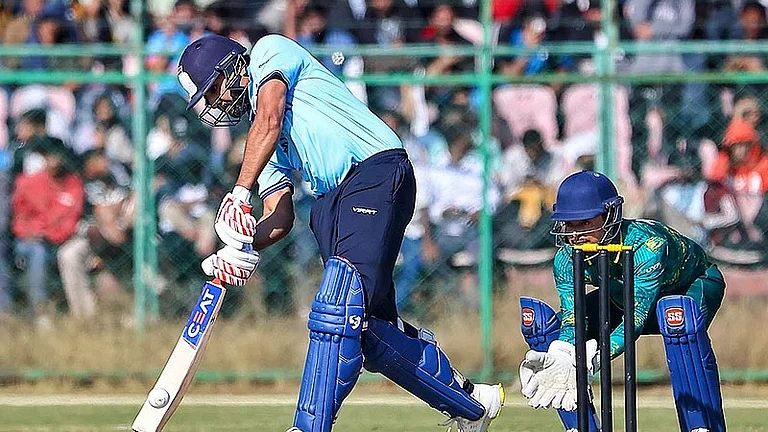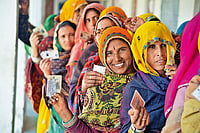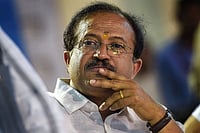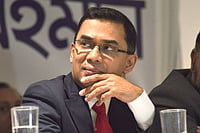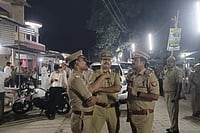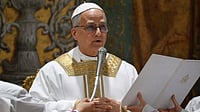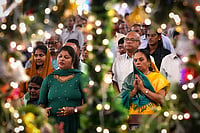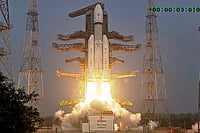AMBASSADORS come and ambassadors go, but Laxmi Mal Singhvi, outgoing Indian high commissioner in London, will leave behind impressions that in polite diplomatese can only be termed 'unusual'. In town and village, in city and countryside, in universities and town halls, in parks and offices, England is saying: Singhvi Was Here. The Indian high commissioner, who two years ago had publicly welcomed a Labour resolution that spoke of Kashmir as an area separate from India and which supported a plebiscite, is now busy with pursuits of a different kind. 'His Excellency Dr L.M. Singhvi' is inscribing his name in some of the most public places in Britain.
Take a walk down Tavistock Square near the British Museum. It was here that former British prime minister Harold Wilson inaugurated a statue of Gandhi in 1968. Recording that act, a plaque on the vertical face of the steps leading up to the statue proclaims: "This statue erected under aegis of the India League by the Mahatma Gandhi Memorial Committee was unveiled on 17th May 1968 by the Prime Minister the Rt Hon. Harold Wilson, MP." Last year, Singhvi had another plaque placed under the statue, right above the Wilson plaque and about three times its size, saying: "Placed here to commemorate the 125th anniversary of the birth of Mahatma Gandhi by His Excellency the High Commissioner for India Dr L.M. Singhvi and the Mayor of Camden Cllr Dr S.N.
Deshmukh, 2nd October 1996." In the polite world of diplomatic protocol this was, an official said, "an outrage". A high commissioner does not put up a plaque above one placed by the prime minister of the host country. Some officials were livid, others said they were embarrassed. "I think if the British high commissioner in India were to put up a plaque above that put up somewhere by an Indian prime minister, you'd have heard something by now," said one. "At Rajghat our prime ministers and presidents don't put up plaques just to say they are commemorating Gandhi," said another.
But Singhvi went a step ahead. A few yards away in the same square stands a tree presented by Jawaharlal Nehru back in 1953. Singhvi put up another plaque here saying he had "recommissioned" the plaque. There is, an official acknowledged, "no precedent as far as we know of recommissioning a plaque." Singhvi simply took credit for identifying the Nehru tree. "But Nehru could have been honoured without Singhvi bringing himself into the plaque," he said. The plaque says: "This Copper Beech Tree was presented by Pandit Nehru on his visit to these gardens on 13th June 1953 in connection with the donation by the St Pancras Borough Council of the site for the erection of astatue to Mahatma Gandhi. This plaque was recommissioned and unveiled by H.E. Dr L.M. Singhvi High Commissioner for India on 30th January 1997."
One square, two plaques. But there are hundreds more. On trees the high commissioner has planted all over Britain in the last four years. Whoever they honour, they never forget Singhvi. All this was evidently inspired by a tree planted jointly by former prime ministers Narasimha Rao and John Major at Runnymeade near London where the Magna Carta, the first British covenant to democracy, was signed in 1215, Singhvi's 'tree plantation programme', as the High Commission officially called the effort, was initially aimed at planting 125 trees to mark the 125th birth anniversary of Mahatma Gandhi from October 1994 to 1995. But after the 125th tree had been planted at the Queens Garden in Hull, Singhvi continued to plant trees, as many as 500, commemorating about 150 other events, planting sometimes a dozen trees at a single event, two per week at any rate. So whether it's the Society for the Study of Normal Psychology in London, the Aberdeen City Council, the Nottingham Community Centre, the Guru Ravidass Bhavan in Birmingham, the Brent Town Hall, Oxford University, the Victoria and Albert Museum or the Hillhead High School in Glasgow, you'd never miss a Singhvi tree, be they the Indian Horse Chestnut, Pride of India or the Evergreen Oak.
Horticultural diplomacy evidently has as much merit as cultural diplomacy for Singhvi; these trees serve to promote Indo-British friendship across Britain, says an official of the Indian high commission. "The trees were planted to symbolise the message of India and to remind people in this country of the heritage of India." The tree is planted by a gardener, the plaque displayed in front and a red ribbon around it. All Singhvi and his British counterpart have to do is shovel the soil around the tree, untie the ribbon and record the achievement back in office.
But even as Singhvi continues to plant trees, he hasn't lost sight of his original intention: of commemorating the Mahatma's 125th birth anniversary. And so he's ordered 100 Gandhi busts, to be sent, among others, to the Harrow Council, the University of Bradford, Shetland Islands and more importantly 10 Downing Street and the Foreign and Commonwealth Office. The Gandhi busts honour the Mahatma as an "Apostle of Peace, Non-violence and Humanity". But that's all they say about Gandhi in a single line below the bust. The next six lines go on to say: "Presented by H.E. Dr L.M. Singhvi High Commissioner for India in commemoration of Mahatma Gandhi's 125th Birth Anniversary Year. Gifted by Jamnalal Bajaj Foundation, India". And while officials might crib about the little that's said on Gandhi, and the lot that's been said about the donors, Singhvi seems satisfied.
Meanwhile, he is working on another set of ties—neck-ties. In the last one year Singhvi has distributed scores of what have come to be known as the Singhvi neck-ties to high-profile Indians and Britishers. "Tie of Inter-faith Amity Launched by H.E. Dr L.M. Singhvi Indian High Commissioner in UK, 100 per cent Polyester by Designer Neckwear", says the label. That 'inter-faith amity' is seen in an intertwining "om", cross, wheel, the palm of a hand and other such symbols of different faiths. Besides such touching plurality, Singhvi's concerns with jurisprudence and the UN make an appearance in the shape of the scales of a balance and the UN logo.
If you thought that was it, watch out for more. Marking the 50th anniversary of Indian Independence, Singhvi is handing out custom-made HMT wrist-watches with the words "Vasudhaiva Kutumbakam/The world is one Family" inscribed full on the face and the Independence anniversary logo below. On its back, it says the watch has been "conceptualised by H.E. Dr L.M. Singhvi".A senior official said HMT had supplied the watches at prices considerably below the market rate, but he could not say who'd paid for them even though both the tie and the watch were designed by Singhvi.
Clearly, Singhvi is a jolly good fellow. At a dinner held last month to mark the 50th year of independence, enough money was raised for four fellowships—one at Wales, one at Cambridge, one to alternate between Hull and Oxford and one in India. At least two of the fellowships, at Wales and the one between Hull and Oxford, have been named after Singhvi. Earlier Singhvi set up the L.M. Singhvi Parliamentary and Judicial Fellowships, sponsored by businessman Raj Loomba who chaired the dinner. Judiciously named. For, Singhvi soon presented Loomba with an 'Asian of the Year' award.
In one way or another, at one place or another, the Singhvi name now dots Britain. New high commissioner Salman Hai-der will face the Gandhi bust with the Singhvi plaque at home, see
Singhvi's name on a tree outside his official residence when he leaves in the new Rolls Royce ordered by Singhvi, and arrive in office to see Singhvi's name again on a Gandhi bust. No other high commissioner in London, Krishna Menon or Vijayalakshmi Pandit among them, managed to "leave their name behind" the way Singhvi will.
"It's the established custom that when trees are planted ceremonially or busts presented, the name of the person presenting the sculpture or planting the tree is written. In the end what will endure is not the name of Singhvi but that the High Commissioner of India planted a tree," explains an official of the commission. The trees, he said, had been planted to commemorate Gandhi and Indian personalities like Nehru, Ambedkar and Vivekananda. But Singhvi has had his name put on plaques even where he's gone as spectator. When former external affairs minister Pranab Mukherjee unveiled a portrait to honour Krishna Menon—the first Indian High Commissioner to Britain—at the Nehru Centre, the plaque recorded that Pranab Mukherjee had unveiled the portrait "in the presence of H.E. Dr L.M. Singhvi, High Commissioner for India".
To be sure, the legacy Singhvi leaves behind may not be significant; but it is like none other.







